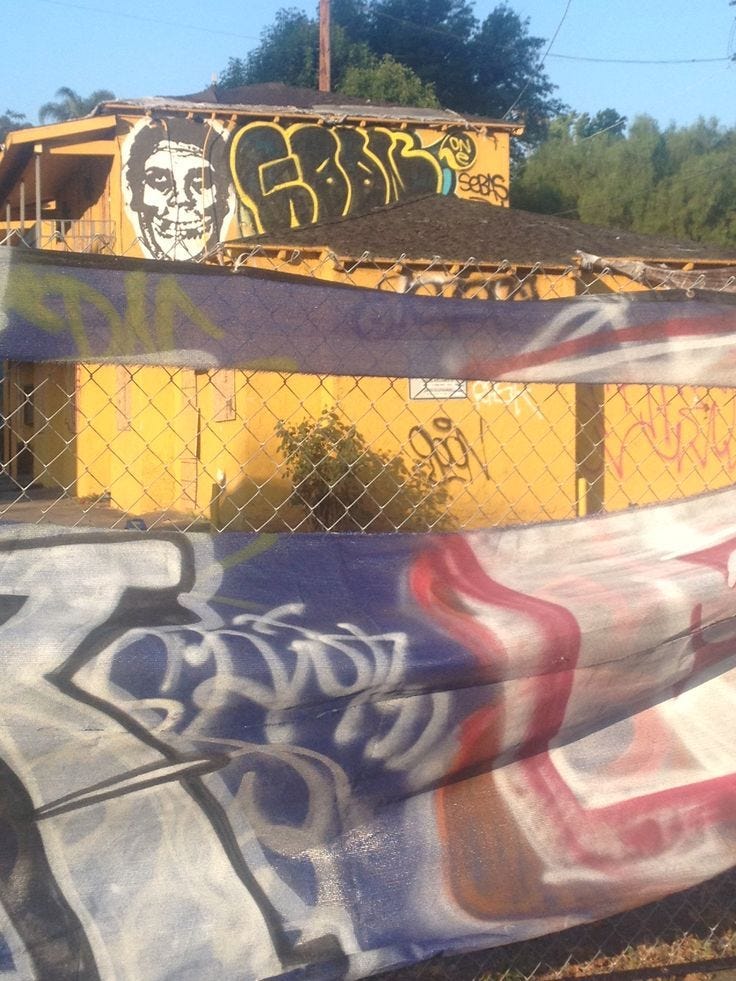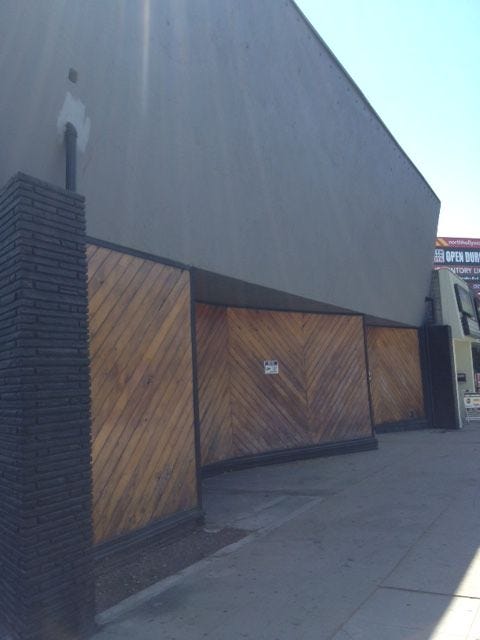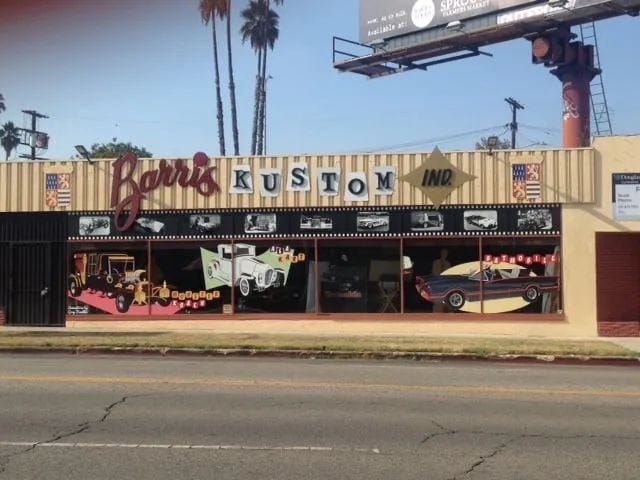Simulpocalypse #5: Why do we have so many vacant buildings in the U.S.?
A now forgotten futurist wrote about a colossal change in society 45 years ago. He was right.
We all know what happens if vacant buildings are left empty for too long. Vandals and taggers find them, and they become graffiti and street art spots, and usually a party or thrash spot for the locals. As word gets around, UrbEx enthusiasts may sneak in to explore, and document the place with photos and video. Once those things happen, the value of the property drops precipitously, bringing down other property values nearby. This was an abandoned motel on Ventura Boulevard, in the Universal City/Studio City area of the San Fernando Valley, in 2021. This motel has been demolished since. #steveemigphotos
Check out my Simulpocalypse Pinterest board
Simulpocalypse- (SIGH-mole-pock-uh-lips)- This is a word I coined to describe how we have normal, everyday society going on day after day, yet we have an increasing number of vacant and abandoned buildings, and post-apocalyptic looking locations and areas, simultaneously.
The gigantic Packard car factory, the largest manufacturing plant in the United States in the early 1900’s, a complex spread over several city blocks in Detroit, Michigan, has been abandoned for over 20 years. The 2.4 million square foot Sears department store headquarters now sits abandoned, but repeatedly explored, in Illinois. Initially called Jazzland, later the Six Flags New Orleans amusement park, has been abandoned for nearly 20 years now, after being flooded during Hurricane Katrina in 2005. About fifty miles northeast of downtown Los Angeles, the former George Air Force Base, has been abandoned for decades. These are just four of the biggest, totally post-apocalyptic looking sites in the United States today. There are thousands of vacant and abandoned houses, buildings and larger locations in our country right now, with more being added on a regular basis.
According to a quick Google search, there are now an estimated 70,000 vacant buildings and 31,000 empty houses just in Detroit, Michigan. There are 13,000 empty houses and buildings in the steel industry centered town of Gary, Indiana. The interwebs tell us that there are now between 5,000 and 20,000 empty buildings in New Orleans, thanks largely to Hurricane Katrina, in 2005. Another search says there are somewhere between 5 million and 15 million empty houses in the United States. Yes, that’s a really wide range. That number includes people’s second homes, cabins in the woods, beach cottages, condos left empty for investments, currently vacant rental houses, as well as fully abandoned, dilapidated homes.
An odd fact of the Information Age is that it’s really hard to find accurate, up-to-date information on many subjects. The total number of vacant and abandoned buildings in the U.S. is one of those subjects. Whatever the actual, current number is, there are a lot of empty buildings in this country. There are tens of thousands commercial buildings and millions of houses sitting empty right now. There are hundreds, probably thousands, in many in other countries, as well. Why are there so many empty buildings in the United States? That’s what this whole Simulpocalypse series of posts is all about.
This very boring looking storefront in North Hollywood, California was empty and unused for a few years, one of thousands of vacant retail, and other commercial buildings, sitting over the last ten years. This building had a secret, for 43 years it housed The Alley music rehearsal space and recording studio. Believe it or not, Michael Jackson recorded three albums in this building. Prince recorded two. Bands ranging from Three Dog Night and Little Feat in the 1970’s, to the Red Hot Chili Peppers, The Interrupters, and other current bands, practiced, wrote songs, and recorded here. From 1973 until 2016, this building housed many of the greatest musicians in the world while they made music. After the owners Bill and Shiloh both died in the 2010’s, having no heirs, the building languished. In the last year it has been reborn as a paint store. #steveemigphotos
As one of the older members of what’s now called Generation X, my childhood years were the 1970’s, when the Industrial Age was still going strong, and it seemed like it would never end. I lived in Ohio and Indiana until I was almost 14, moving a lot through a series of rural areas, and small towns and cities. The factories across Ohio and the Midwest were thriving during my childhood. Many manufacturing plants had two, or even three, 8 hour shifts of workers working, five or six days a week. The storefronts in all of those small downtown areas were filled with mom and pop run businesses. There were small hardware stores, bakeries, dry cleaners, clothing stores, local diners, bars, pool halls, and usually a laundromat and a little burger stand with tables outside, busy only in the warm months. Over half of the U.S. population lived in small cities, towns and rural areas then. In those days before video games, the internet, cell phones, and personal computers, us kids played outside, and we were always exploring. But we were usually exploring local creeks or the woods, not cyberspace.
I only remember one abandoned house as a kid. Someone heard it was haunted. We managed to sneak in, a little pack of 9-year-olds, and we explored it. Someone moved out, and no one moved in for more than a year. Looking back, the owner probably died, and had no heirs, or maybe the heirs lived in a different state. I think the property was probably tied up in probate proceedings. The house didn’t get vandalized, except that I think one of the kids peed in a closet. New locks were put on the doors shortly after we broke in. Abandoned factories, stores, or other vacant buildings were not a thing then. Some farms had an old, broken down barn, many decades old, but that was about it. Stores had businesses in them, factories were manufacturing things, and every house had a family in it.
Now, in 2025, according to this website, there are about 350,000 commercial buildings in the country. The site says about 5% of those, which would be 17,500 buildings total, are currently empty. The actual number is most likely higher now. There are so many vacant and fully abandoned buildings these days, that exploring them, known as urban exploring or UrbEx, is a thing, and has been since sometime in the 1990’s. There are dozens and dozens of videos on YouTube, many of them well made mini-documentaries, about abandoned buildings all over the U.S. and the world.
What happened? Why are there vacant and abandoned commercial buildings and houses in pretty much every town and city now? There’s one Big Picture concept, published in a book 45 years ago, that I think explains the Simulpocalypse better than any other concept or theory.
In 1980, a futurist writer named Alvin Toffler published a book called The Third Wave. In over 400, incredibly well researched pages, he explained a radical idea. Toffler believed that the U.S., and major industrialized nations, were in the beginning stages of a huge transition period. He wrote that we were leaving the industrial-based society we all grew up in, and were moving into an information-based society. In today’s world, he told us we were leaving what we now call the Industrial Age, and moving into the Information Age.
Now, 45 years later, that basic idea is well known, most of us have heard it somewhere. If Toffler was right, it meant that huge changes were coming in technology, manufacturing, communication, and every other aspect of society. What most people never stop to think about is that we are still in this long transition period between these two different types of society.
The first Batmobile, built for for the 1966 TV show, was designed and built in this shop, in North Hollywood, California. For decades, custom car builder George Barris and his team created custom cars for individuals, TV shows, and movies. Those ranged from The Munsters in the 1960’s to the Power Ranger movies decades later. The shop kept going for a while, after George’s death in 2015. Eventually, it closed, and the building sat, vacant and unused for a couple of years. Now there’s another mechanic’s shop in this property. #steveemigphotos
Brainstorming with his wife Heidi for decades, Alvin Toffler concluded that the First Wave of human civilization led humans from tribal communities, what sociologists call the hunter/gatherers, into the Agricultural Age, beginning about 10,000 years ago. That transition took thousands of years, and changed daily life for nearly everyone on Earth. The Second Wave was the transition from the Agricultural Age into the Industrial Age, which took a couple of centuries. The Third Wave transition began in 1956, according to The Third Wave, written 45 years ago.
Yes, 1980 seems like the ancient past to most people now. But the ideas Alvin Toffler introduced us to back then are still playing out, 19 years after his last book, and nearly 9 years after his death, in 2016. He introduced us to the idea of the emerging Information Age, and now the general idea is common knowledge. But few people realize that American society is still in the transition into the early stages of a true, functional Information Age. We are not there yet. That’s the key distinction to understand now, in 2025.
This is why we have so many buildings that are no longer used for their original purpose, tens of thousands of which are now vacant, many totally abandoned and left to rot. In the post World War II years, from 1946 into the late 1970’s, we had a fully developed Industrial Age. We had the factories, warehouses, local retail stores, shopping centers, malls, and department stores, the urban infrastructure, and houses where they needed to be, for a functioning Industrial Age. But the emerging Information Age requires different types of buildings, different types of infrastructure, different shopping areas, and different types of houses and apartments. Many of those different types of buildings and infrastructure need to be located in different places from the old, Industrial Age buildings. But with tens of thousands of empty buildings nationwide, there should be many that can be adapted to serve new purposes for the Information Age.
When I talk about infrastructure, I’m saying that 40 years ago we didn’t need thousands of miles of fiber optic cable, cell phone towers, server farms, and many other forms of infrastructure we take for granted now. The largest major corporations now are mostly high tech related firms, and they tend to cluster in a small number of large metro areas. The San Francisco Bay area, Seattle, New York City, L.A./Orange County, California, Boston, Massachusetts, Austin, Texas, and the Washington D.C. metro area, are the largest tech hubs today. There are several other regions with smaller concentrations of high tech businesses, like the Raleigh Research Triangle, Chicago, and more recently, Atlanta, Georgia, among others. These regions have been drawing our nation’s “best and brightest” young minds and tech talent away from the rest of the country for roughly 40 years.
Today’s major companies, and the jobs in them, are not spread very evenly across large, medium, and small sized cities and towns, like factories in the Industrial Age were. Because of this, we have lots of houses that are unwanted or really inexpensive in many areas, and highly priced housing in major metro areas. Because people are busier now, and have cell phones and laptops, most people shop online or on phone, for many of their needed products. So we need far fewer shopping malls, shopping centers, and small, local, retail stores now. Because so many people can work from home now, and because the pandemic drove larger numbers of people to begin to work from home, we need far fewer office buildings than we did in the Industrial Age.
We now have several waves of vacant and abandoned buildings, apparent to those who look for them. Because of new technology, the rise of industrial robots, and outsourcing of jobs becoming economically viable, thousands of factories in the U.S. shut down since the late 1970’s. Boom… lots of empty factories. With the closing of all those factories came the migration of millions of workers out of many older, industrial cities. Boom… tens of thousands of empty houses. Years later, with the rise of online and on-phone shopping, we needed far fewer retail stores, shopping centers, and shopping malls. Boom… empty retail stores and dead malls. With the rise of the internet, social media, and the various home office machines and technology, and the pandemic, came millions of people working from home. Boom… empty office buildings. Many of these are the older buildings, and those in mid-sized and smaller cities and towns.
With this huge, societal shift, The Third Wave Alvin Toffler first reported decades ago, the huge number of empty buildings today can be largely explained. To those you can add in environmental catastrophes, like Hurricane Katrina’s effect on New Orleans in 2005, or the area around the continually evaporating Salton Sea, in Southern California. In the past few decades, most of the buildings, what I now call the Simulpocalypse, can be explained. There other factors, but these two are the biggest forces driving thousands of buildings into becoming vacant, with some winding up completely abandoned.
The question now is, how many of these thousands of buildings can be salvaged, repurposed, and used in the emerging Information Age? I think the answer is that a lot more buildings can find new uses than is happening right now.
There are no paid links in this post.





